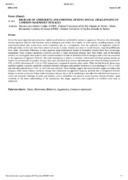Use este identificador para citar ou linkar para este item:
https://repositorio.ufrn.br/handle/123456789/24166Registro completo de metadados
| Campo DC | Valor | Idioma |
|---|---|---|
| dc.contributor.author | Coelho, Nicole Leite Galvão | - |
| dc.contributor.author | Sousa, Maria Bernardete Cordeiro de | - |
| dc.date.accessioned | 2017-11-06T11:35:20Z | - |
| dc.date.available | 2017-11-06T11:35:20Z | - |
| dc.date.issued | 2010-09 | - |
| dc.identifier.uri | https://repositorio.ufrn.br/jspui/handle/123456789/24166 | - |
| dc.language | eng | pt_BR |
| dc.rights | Acesso Aberto | pt_BR |
| dc.subject | Stress | pt_BR |
| dc.subject | Hormones | pt_BR |
| dc.subject | Behavior | pt_BR |
| dc.subject | Aggression | pt_BR |
| dc.subject | Common marmosets | pt_BR |
| dc.title | Release of androgens and cortisol during social challenging in common marmoset females | pt_BR |
| dc.type | article | pt_BR |
| dc.description.resumo | One of the most important and extensively studied social behaviors exhibited by animals is aggression. However, the relationships between agonistic behavior and hormones such as androgens and cortisol are complex. In some species, including humans, a high testosterone/cortisol ratio results from social competition and, as a consequence, from the expression of aggressive behavior. Although studies in this area have been carried out mostly in males, females also react to social stressors, responding differently from males. Sex-related differences in stress response using experimental models in biomedical research have been increasingly emphasized. Since common marmosets (Callithrix jacchus), a small neotropical primate, have been widely used in biomedical research, we investigated three dyads of adult common marmoset females to determine if fecal androgens and cortisol are associated to the expression of aggressive behavior. The study encompasses 3 phases: (1) baseline, which starts with dyad pairing, lasting one month; (2) isolation and (3) reunion, lasting 7 days each. Increased fecal cortisol and androgens were observed during isolation (F= 4.29; p= 0.01) and reunion (F= 4.16; p= 0.02) respectively, compared to baseline phase values. When the data from all phases were analyzed together, a positive significant correlation between androgens and agonistic behaviors of scent-marking (r= 0.22; p< 0.05) and individual piloerection (r= 0.43; p< 0.05) was also observed. These findings suggest that social isolation triggers an anxiety-like response, while reunion induces hormonal changes that characterize an aggressive response, probably due to competition between females to restore social rank. Future studies focusing on factors that could be interfering in the endocrine and behavioral response to social and nonsocial challenges in males and females, such as relatedness and previous social dynamics between females, might contribute to the better understanding of the mechanisms that trigger aggression and competition to establish social rank in marmosets. | pt_BR |
| Aparece nas coleções: | ICe - Trabalhos apresentados em eventos | |
Arquivos associados a este item:
| Arquivo | Descrição | Tamanho | Formato | |
|---|---|---|---|---|
| SBNeC 2010.pdf | 181,03 kB | Adobe PDF |  Visualizar/Abrir |
Os itens no repositório estão protegidos por copyright, com todos os direitos reservados, salvo quando é indicado o contrário.

